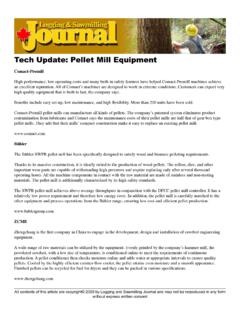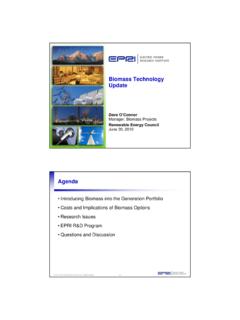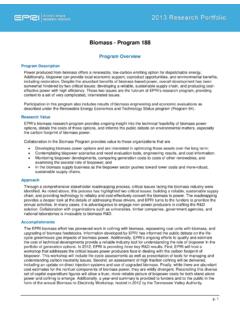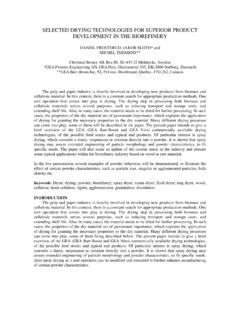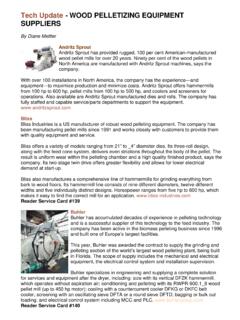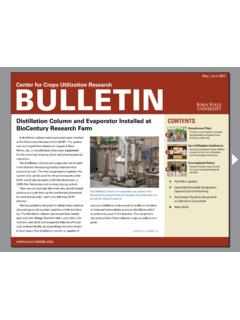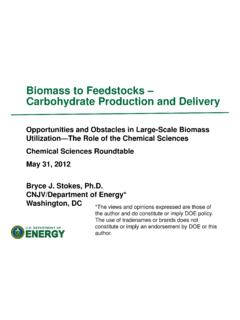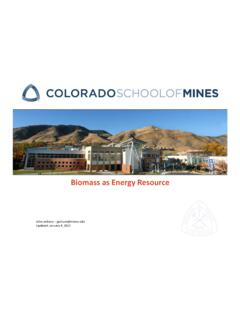Transcription of II.B.1 Indirectly Heated Gasification of Biomass to ...
1 58 DOE Hydrogen Program FY 2009 Annual Progress ReportRichard BainNational Renewable Energy Laboratory (NREL)1617 Cole Boulevard, MS3317 Golden, CO 80401 Phone: (303) 384-7765; Fax: (303) 384-6363E-mail: technology Development Manager: Rick FarmerPhone: (202) 586-1623; Fax: (202) 586-2373E-mail: Start Date: August 2007 Project End Date: September 2009 Objectives Verify the technical and economic performance of an integrated Biomass steam Gasification -based hydrogen production process that includes steam Gasification , tar and light hydrocarbon reforming, hydrogen sulfide removal, shift reaction, and hydrogen Gasification of two Biomass feedstocks. Gas cleanliness verification with slip stream hydrogen sulfide removal and high temperature shift.
2 update of gas yield correlations. update of ASPEN process simulation model. update of H2A technoeconomic model. Technical BarriersThis project addresses the following technical barriers from the Production section ( ) of the Hydrogen, Fuel Cells and Infrastructure Technologies (HFCIT) Program Multi-Year Research, Development and Demonstration (RD&D) Plan:(T) Capital Cost and Efficiency of Biomass Gasification /Pyrolysis technology t. Indirect steam Gasification efficiency u. Capital cost v. Tar/light hydrocarbon reformingTechnical TargetsThis project is directed at the verification of the technical and economic performance of a hydrogen production process using integrated Biomass steam Gasification .
3 The project experimentally developed Gasification data that were used to develop updated gasifier yield and quality estimates. These estimates were used in an updated ASPEN material and energy balance simulation of an integrated Biomass to hydrogen process. Yield and capital and operating cost estimates resulting from the simulation were used to update the H2A model for the process. This project addresses the following DOE technical targets outlined in Table of the HFCIT Multi-Year RD&D Plan:Technical Targets: Biomass Gasification /Pyrolysis Hydrogen ProductionCharacteristics2012 Target2017 TargetHydrogen Cost (Plant Gate) ($2005)$ $ Capital Investment ($2005)$150M$110 MEnergy Efficiency (LHV)43%60%LHV - lower heating valueAccomplishments Completed parametric steam Gasification testing and data reduction and analysis for pine feed:Three temperatures: 750 C, 850 C, 950 C Three steam/ Biomass ratios: , , 2 Completed multivariate analysis and updated gasifier yield gasifier correlations to ASPEN.
4 Updated the existing H2A model. G G G G GIntroduction Through the auspices of DOE s HFCIT Program and based on DOE supported Gasification research [1], NREL developed gasifier yield correlations for Indirectly Heated steam Gasification of Biomass . These results were used by NREL [2] and others [3] to indicate the feasibility of producing hydrogen and other fuels from Biomass . These studies also showed the benefits of catalytically converting high-molecular weight contaminants (tars) and light hydrocarbons ( , methane, ethane) in one unit operation. These early efforts were used by NREL to develop detailed ASPEN models and associated economic models [4] that in turn were used to provide yield, capital cost, and operating cost data for use in H2A.
5 These models and analyses indicate that hydrogen production from Biomass may be a viable production pathway. Costs developed in the technoeconomic modeling effort resulted in estimated hydrogen costs of $ (current) and $ (advanced in 2015). Indirectly Heated Gasification of Biomass to Produce Hydrogen59FY 2009 Annual Progress ReportDOE Hydrogen Program Hydrogen Production / Biomass GasificationRichard Bain National Renewable Energy LaboratoryWhile these estimates are encouraging, they are based on non-integrated pilot scale data generated by Battelle Columbus Laboratories (BCL) in the 1980s. To give additional credibility to the estimates, additional independent verification testing was required.
6 This project provided: Experimental data needed to update Gasification yields and gas compositions using the NREL pilot development Gasification on contaminants and effectiveness of removal. Updated H2A analysis for Program evaluation. Approach The NREL 150 kWt (maximum of 30 kg/h Biomass throughput) thermochemical pilot development unit (TCPDU), Figure 1, was operated to investigate integrated Gasification -hydrogen production to generate a raw syngas using a two-stage gasifier (fluid bed and entrained flow thermal cracker), which is cleaned a) using cyclones for particulate matter and an organic quench for tars, water and ammonia; and b) using cyclones, a fluid bed tar reformer, and an organic quench.
7 During operations with the tar reformer, production of a hydrogen-rich syngas in a micro-scale pressurized catalytic reactor system under high temperature shift conditions was also evaluated. A molecular beam mass-spectrometer system was used to quantify benzene and tars in the syngas before and after the quench. Permanent gases and sulfur compounds (H2S and COS) were quantified using gas chromatography and non-dispersive infrared analyses. In combination with experimental material balances, updated correlations of gas yield and quality were developed and new ASPEN simulations performed. Economic analyses using H2A protocols were used to compare results with published information.
8 Results The project is divided into three tasks: 1) experimental testing, 2) development of gasifier correlations, and 3) updating of ASPEN model and incorporation into an H2A model. The results section discusses these three 1: Experimental TestingIn general, a higher steam-to- Biomass ratio and a higher thermal cracker temperature yielded a higher hydrogen concentration. The hydrogen concentration Figure 1. NREL Thermochemical Pilot Development UnitRichard Bain National Renewable Energy Hydrogen Production / Biomass Gasification60 DOE Hydrogen Program FY 2009 Annual Progress Reportranged from 26 39% vol (dry, N2-free) for oak and 35 42% vol for pine Gasification .
9 The carbon monoxide concentration ranged from 18 31% vol for oak and 15 23% vol for pine. The H2/CO ratio for oak varied between and with an average of The H2/CO ratio for pine varied between and with an average of Overall mass closures of 88 100% during the parametric oak Gasification studies and 86 100% during the pine Gasification studies were achieved. Qualitative tar measurements were very similar between the two catalyst tests were first performed using bottled gases with an H2:CO ratio of , which is representative of the syngas produced in the TCPDU when the tar reformer is online. A CO conversion of 74% was obtained using a shift reaction temperature of 450 C (842 F), steam-to-H2 ratio of , and a gas hourly space velocity of 21,000 h-1.
10 The H2:CO ratio increased from at the inlet to 17 at the outlet. The TCPDU was then used to generate pine-derived syngas at a steam-to- Biomass ratio of and a thermal cracker temperature of 850 C. Using the same shift reactor conditions as in the bottled gas test, the CO conversion using pine-derived syngas was initially 68%. After 6 hours, the CO conversion decreased to 65%. The H2:CO ratio increased from at the inlet to 14 at the outlet. The change in H2:CO ratio is shown graphically in Figure 2: Gasifier Correlations The NREL Gasification tests examined the effects of several process variables on the gasifier product yields and compositions ( , char production rate, tar rates, and dry gas composition) using oak and pine, plus separate data for wheat straw, Vermont wood, and corn data collected during the NREL Gasification tests were subjected to a regression analysis using Unscrambler statistical software.










